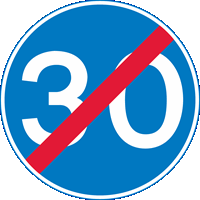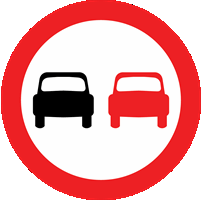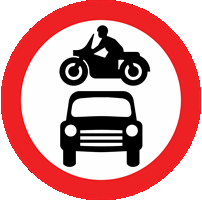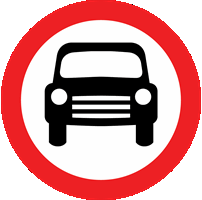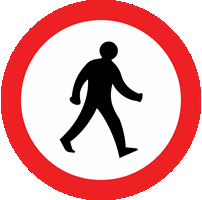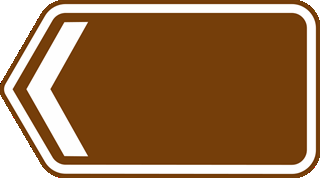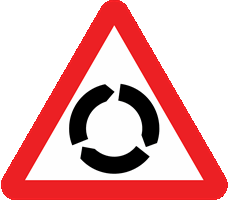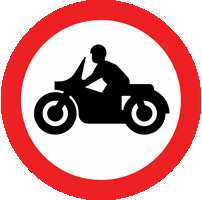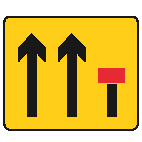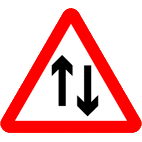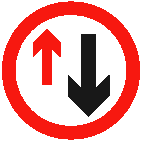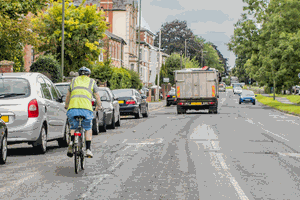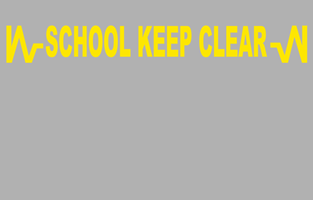You have 57 minutes to answer 50 multiple choice driving theory test questions. At least 43 out of 50 questions must be answered correctly in order to pass the test. Answers may be reviewed after each question or you can wait until the end of the test for your final score. Good luck!
Test Quick View
Click on an answer to view the correct choice along with the explanation.
1. What's the minimum time gap you should leave when following a vehicle on a wet road? Mark one answer
AB
C
D
Correct Answer: A
Explanation: Water will reduce your tyres' grip on the road. The safe separation gap of at least two seconds in dry conditions should be doubled, to at least four seconds, in wet weather.
Explanation: Water will reduce your tyres' grip on the road. The safe separation gap of at least two seconds in dry conditions should be doubled, to at least four seconds, in wet weather.
Correct Answer: B
Explanation: The red slash through the sign indicates that the restriction has ended. In this case, the restriction was a minimum speed limit of 30 mph.
Explanation: The red slash through the sign indicates that the restriction has ended. In this case, the restriction was a minimum speed limit of 30 mph.
3. What should you do if you want to overtake a tractor but aren't sure that it's safe? Mark one answer
AB
C
D
Correct Answer: D
Explanation: Following a tractor can be frustrating, but never overtake if you're unsure whether it's safe. Ask yourself: 'Can I see far enough down the road to ensure that I can complete the manoeuvre safely?' It's better to be delayed for a minute or two than to take a chance that may cause a collision.
Explanation: Following a tractor can be frustrating, but never overtake if you're unsure whether it's safe. Ask yourself: 'Can I see far enough down the road to ensure that I can complete the manoeuvre safely?' It's better to be delayed for a minute or two than to take a chance that may cause a collision.
Correct Answer: B
Explanation: This sign is used to enable pedestrians to walk free from traffic. It's often found in shopping areas.
Explanation: This sign is used to enable pedestrians to walk free from traffic. It's often found in shopping areas.

B
C
D
Correct Answer: B
Explanation: Signs with blue circles generally give mandatory instruction. These are often found in urban areas and include signs for mini-roundabouts and directional arrows.
Explanation: Signs with blue circles generally give mandatory instruction. These are often found in urban areas and include signs for mini-roundabouts and directional arrows.
Correct Answer: D
Explanation: Signs with a brown background give directions to places of interest. They're often seen on a motorway, directing you along the easiest route to the attraction.
Explanation: Signs with a brown background give directions to places of interest. They're often seen on a motorway, directing you along the easiest route to the attraction.
Correct Answer: D
Explanation: As you approach a roundabout, look well ahead and check all signs. Decide which exit you wish to take and move into the correct position as you approach the roundabout, signalling as required.
Explanation: As you approach a roundabout, look well ahead and check all signs. Decide which exit you wish to take and move into the correct position as you approach the roundabout, signalling as required.
Correct Answer: B
Explanation: This sign shows you that you can't get through to another route by turning left at the junction ahead.
Explanation: This sign shows you that you can't get through to another route by turning left at the junction ahead.
9. You see these double white lines along the centre of the road. When may you park on the left? Mark one answer
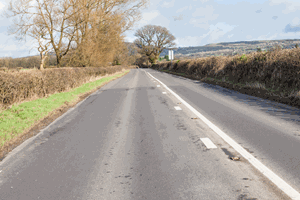
B
C
D
Correct Answer: C
Explanation: You mustn't park or stop on a road marked with double white lines (even where one of the lines is broken) except to pick up or set down passengers.
Explanation: You mustn't park or stop on a road marked with double white lines (even where one of the lines is broken) except to pick up or set down passengers.
Correct Answer: C
Explanation: Try to plan your journey so that you can take rest stops. It's recommended that you take a break of at least 15 minutes after every two hours of driving or riding. This should help to maintain your concentration.
Explanation: Try to plan your journey so that you can take rest stops. It's recommended that you take a break of at least 15 minutes after every two hours of driving or riding. This should help to maintain your concentration.
11. How should you position yourself when you use the emergency telephone on a motorway? Mark one answer
AB
C
D
Correct Answer: A
Explanation: Traffic is passing you at speed. If the draught from a large lorry catches you by surprise, it could blow you off balance and even onto the carriageway. By facing the oncoming traffic, you can see approaching lorries and so be prepared for their draught. You'll also be in a position to see any other hazards approaching.
Explanation: Traffic is passing you at speed. If the draught from a large lorry catches you by surprise, it could blow you off balance and even onto the carriageway. By facing the oncoming traffic, you can see approaching lorries and so be prepared for their draught. You'll also be in a position to see any other hazards approaching.
Correct Answer: D
Explanation: You must comply with all traffic signs and be especially aware of those signs that apply specifically to the type of vehicle you're using.
Explanation: You must comply with all traffic signs and be especially aware of those signs that apply specifically to the type of vehicle you're using.
13. You're on a motorway. A lorry has stopped in the right-hand lane. What should you do when you see this sign on the lorry? Mark one answer
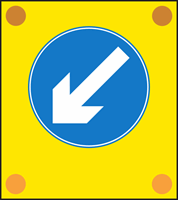
B
C
D
Correct Answer: C
Explanation: Sometimes work is carried out on the motorway without closing the lanes. When this happens, signs are mounted on the back of lorries to warn other road users of the roadworks ahead.
Explanation: Sometimes work is carried out on the motorway without closing the lanes. When this happens, signs are mounted on the back of lorries to warn other road users of the roadworks ahead.
Correct Answer: D
Explanation: Normally you should travel in the left-hand lane and only use the right-hand lane for overtaking or turning right. Move back into the left lane as soon as it's safe but don't cut in across the path of the vehicle you've just passed.
Explanation: Normally you should travel in the left-hand lane and only use the right-hand lane for overtaking or turning right. Move back into the left lane as soon as it's safe but don't cut in across the path of the vehicle you've just passed.
Correct Answer: C
Explanation: Even though you have priority, be prepared to give way if other drivers don't. This will help to avoid congestion, confrontation or even a collision.
Explanation: Even though you have priority, be prepared to give way if other drivers don't. This will help to avoid congestion, confrontation or even a collision.
16. Other drivers may sometimes flash their headlights at you. What's the official meaning of this signal? Mark one answer
AB
C
D
Correct Answer: D
Explanation: If other drivers flash their headlights, this isn't a signal to show priority. The flashing of headlights has the same meaning as sounding the horn: it's a warning of their presence.
Explanation: If other drivers flash their headlights, this isn't a signal to show priority. The flashing of headlights has the same meaning as sounding the horn: it's a warning of their presence.
A
B
C
D
B
C
D
Correct Answer: D
Explanation: If the road surface becomes very hot, it can soften. Tyres are unable to grip a soft surface as well as they can a firm dry one. Take care when cornering and braking.
Explanation: If the road surface becomes very hot, it can soften. Tyres are unable to grip a soft surface as well as they can a firm dry one. Take care when cornering and braking.
Correct Answer: C
Explanation: When following a cyclist, be aware that they have to deal with the hazards around them. They may wobble or swerve to avoid a pothole in the road or see a potential hazard and change direction suddenly. Don't follow them too closely or rev your engine impatiently.
Explanation: When following a cyclist, be aware that they have to deal with the hazards around them. They may wobble or swerve to avoid a pothole in the road or see a potential hazard and change direction suddenly. Don't follow them too closely or rev your engine impatiently.
Correct Answer: C
Explanation: These markings are found on the road outside schools. Don't stop or park on them, even to set down or pick up children. The markings are there to ensure that drivers, riders, children and other pedestrians have a clear view of the road in all directions.
Explanation: These markings are found on the road outside schools. Don't stop or park on them, even to set down or pick up children. The markings are there to ensure that drivers, riders, children and other pedestrians have a clear view of the road in all directions.
Correct Answer: A
Explanation: Although cars are the least likely to be affected, side winds can take anyone by surprise. This is most likely to happen after overtaking a large vehicle, when passing gaps between hedges or buildings, and on exposed sections of road.
Explanation: Although cars are the least likely to be affected, side winds can take anyone by surprise. This is most likely to happen after overtaking a large vehicle, when passing gaps between hedges or buildings, and on exposed sections of road.
21. The road is wet. Why would a motorcyclist steer around drain covers while they were cornering? Mark one answer
AB
C
D
Correct Answer: D
Explanation: Other drivers or riders may have to change course due to the size or characteristics of their vehicle. Understanding this will help you to anticipate their actions. Motorcyclists and cyclists will be checking the road ahead for uneven or slippery surfaces, especially in wet weather. They may need to move across their lane to avoid surface hazards such as potholes and drain covers.
Explanation: Other drivers or riders may have to change course due to the size or characteristics of their vehicle. Understanding this will help you to anticipate their actions. Motorcyclists and cyclists will be checking the road ahead for uneven or slippery surfaces, especially in wet weather. They may need to move across their lane to avoid surface hazards such as potholes and drain covers.
22. An injured motorcyclist is lying unconscious in the road. The traffic has stopped and there's no further danger. What could you do to help? Mark one answer
AB
C
D
Correct Answer: D
Explanation: If someone has been injured, the sooner proper medical attention is given the better. Ask someone to phone for help or do it yourself. An injured person should only be moved if they're in further danger. An injured motorcyclist's helmet shouldn't be removed unless it's essential.
Explanation: If someone has been injured, the sooner proper medical attention is given the better. Ask someone to phone for help or do it yourself. An injured person should only be moved if they're in further danger. An injured motorcyclist's helmet shouldn't be removed unless it's essential.
Correct Answer: D
Explanation: The motorcyclist is in an extremely vulnerable position, exposed to further danger from traffic. Approaching vehicles need advance warning in order to slow down and safely take avoiding action or stop. Don't put yourself or anyone else at risk. Use the hazard warning lights on your vehicle to alert other road users to the danger.
Explanation: The motorcyclist is in an extremely vulnerable position, exposed to further danger from traffic. Approaching vehicles need advance warning in order to slow down and safely take avoiding action or stop. Don't put yourself or anyone else at risk. Use the hazard warning lights on your vehicle to alert other road users to the danger.
Correct Answer: B
Explanation: If a young child has stopped breathing, first check that their airway is open and then begin CPR. With a young child, you may only need to use one hand and you shouldn't press down as far as you would with an adult. Continue the procedure until the child is breathing again or until a medical professional takes over.
Explanation: If a young child has stopped breathing, first check that their airway is open and then begin CPR. With a young child, you may only need to use one hand and you shouldn't press down as far as you would with an adult. Continue the procedure until the child is breathing again or until a medical professional takes over.
25. At an incident, a casualty isn't breathing. What should you do while helping them to start breathing again? Mark one answer
AB
C
D
Correct Answer: A
Explanation: It's important to ensure that the airway is open before you start CPR. To open the casualty's airway, place your fingers under their chin and lift it forward.
Explanation: It's important to ensure that the airway is open before you start CPR. To open the casualty's airway, place your fingers under their chin and lift it forward.
26. You're on a long motorway journey. What should you do if you start to feel sleepy? Mark one answer
AB
C
D
Correct Answer: B
Explanation: If you feel sleepy, you should leave the motorway at a service area or at the next exit and stop in a safe place to rest. A supply of fresh air can help to keep you alert before you reach the exit, but it isn't a substitute for stopping and resting.
Explanation: If you feel sleepy, you should leave the motorway at a service area or at the next exit and stop in a safe place to rest. A supply of fresh air can help to keep you alert before you reach the exit, but it isn't a substitute for stopping and resting.
Correct Answer: B
Explanation: If you're travelling on an icy road, extra caution will be required to avoid loss of control. Keeping your speed down and using the highest gear possible will reduce the risk of the tyres losing their grip on this slippery surface.
Explanation: If you're travelling on an icy road, extra caution will be required to avoid loss of control. Keeping your speed down and using the highest gear possible will reduce the risk of the tyres losing their grip on this slippery surface.
28. You intend to turn left at the traffic lights. What should you do just before turning? Mark one answer
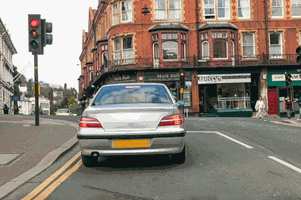
B
C
D
Correct Answer: A
Explanation: If you've been in a queue of traffic and are about to turn left, check your nearside for cyclists as they often filter past on the nearside of slow-moving or stationary vehicles.
Explanation: If you've been in a queue of traffic and are about to turn left, check your nearside for cyclists as they often filter past on the nearside of slow-moving or stationary vehicles.
Correct Answer: C
Explanation: If you feel yourself becoming tired or sleepy, you should leave the motorway at the next exit or services and stop for a rest. If you have to drive a long way, leave earlier and plan your journey to include rest stops. That way, you're less likely to become tired while driving and you'll still arrive in good time.
Explanation: If you feel yourself becoming tired or sleepy, you should leave the motorway at the next exit or services and stop for a rest. If you have to drive a long way, leave earlier and plan your journey to include rest stops. That way, you're less likely to become tired while driving and you'll still arrive in good time.
Correct Answer: D
Explanation: Long-distance driving can be boring. This, coupled with a stuffy, warm vehicle, can make you feel tired and sleepy. Make sure you take rest breaks to help you stay awake and alert. Stop in a safe place before you get to the stage of fighting sleep.
Explanation: Long-distance driving can be boring. This, coupled with a stuffy, warm vehicle, can make you feel tired and sleepy. Make sure you take rest breaks to help you stay awake and alert. Stop in a safe place before you get to the stage of fighting sleep.
31. You're driving at night. What should you do if you're dazzled by headlights coming towards you? Mark one answer
AB
C
D
Correct Answer: D
Explanation: If the headlights of an oncoming vehicle dazzle you, slow down or, if necessary, stop. Don't close your eyes or swerve, as you'll increase your chances of having a collision. Don't flash your headlights either, as this could dazzle other drivers and make the situation worse.
Explanation: If the headlights of an oncoming vehicle dazzle you, slow down or, if necessary, stop. Don't close your eyes or swerve, as you'll increase your chances of having a collision. Don't flash your headlights either, as this could dazzle other drivers and make the situation worse.
Correct Answer: C
Explanation: The speed limit for cars towing caravans or trailers on dual carriageways or motorways is 60 mph. Due to the increased weight and size of the combination, you should plan further ahead. Take care in windy weather, as a strong side wind can make a caravan or large trailer unstable.
Explanation: The speed limit for cars towing caravans or trailers on dual carriageways or motorways is 60 mph. Due to the increased weight and size of the combination, you should plan further ahead. Take care in windy weather, as a strong side wind can make a caravan or large trailer unstable.
33. You're driving on a busy main road. What should you do if you find that you're driving in the wrong direction? Mark one answer
AB
C
D
Correct Answer: C
Explanation: Don't turn around in a busy street or reverse from a side road into a main road. Find a quiet side road and choose a place to turn around where you won't obstruct an entrance or exit. Look out for pedestrians and cyclists as well as other traffic.
Explanation: Don't turn around in a busy street or reverse from a side road into a main road. Find a quiet side road and choose a place to turn around where you won't obstruct an entrance or exit. Look out for pedestrians and cyclists as well as other traffic.
34. You've broken down on a two-way road. You have a warning triangle. At least how far from your vehicle should you place the warning triangle? Mark one answer
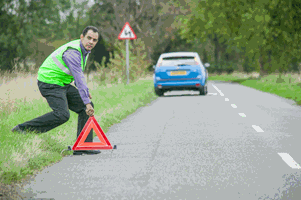
B
C
D
Correct Answer: C
Explanation: Advance warning triangles fold flat and don't take up much room. Use one to warn other road users if your vehicle has broken down or if there has been an incident. Place it at least 45 metres (147 feet) behind your vehicle (or the incident), on the same side of the road or verge. Place it further back if the scene is hidden by, for example, a bend, hill or dip in the road. Don't use warning triangles on motorways.
Explanation: Advance warning triangles fold flat and don't take up much room. Use one to warn other road users if your vehicle has broken down or if there has been an incident. Place it at least 45 metres (147 feet) behind your vehicle (or the incident), on the same side of the road or verge. Place it further back if the scene is hidden by, for example, a bend, hill or dip in the road. Don't use warning triangles on motorways.
A
B
C
D
B
C
D
Correct Answer: A
Explanation: If your vehicle breaks down on a level crossing, your first priority is to get everyone out of the vehicle and clear of the crossing. Then use the railway telephone, if there is one, to tell the signal operator. If you have time before the train arrives, move the vehicle clear of the crossing, but only do this if the alarm signals aren't activated.
Explanation: If your vehicle breaks down on a level crossing, your first priority is to get everyone out of the vehicle and clear of the crossing. Then use the railway telephone, if there is one, to tell the signal operator. If you have time before the train arrives, move the vehicle clear of the crossing, but only do this if the alarm signals aren't activated.
Correct Answer: B
Explanation: If you don't have your vehicle serviced regularly, the engine will gradually become less efficient. This will cause increased fuel consumption and, in turn, an increase in the amount of harmful emissions it produces.
Explanation: If you don't have your vehicle serviced regularly, the engine will gradually become less efficient. This will cause increased fuel consumption and, in turn, an increase in the amount of harmful emissions it produces.
37. You're driving on a one-way street. What should you do if you realise you've taken the wrong route? Mark one answer
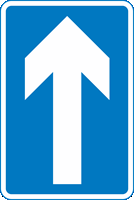
B
C
D
Correct Answer: A
Explanation: Never reverse or turn your vehicle around in a one-way street. It's illegal and could even cause a collision. If you've taken a wrong turn, carry on along the one-way street and find another route, checking the direction signs as you drive. Stop in a safe place if you need to check a map.
Explanation: Never reverse or turn your vehicle around in a one-way street. It's illegal and could even cause a collision. If you've taken a wrong turn, carry on along the one-way street and find another route, checking the direction signs as you drive. Stop in a safe place if you need to check a map.
38. Your vehicle has broken down on a motorway. What should you do if you aren't able to get onto the hard shoulder? Mark one answer
AB
C
D
Correct Answer: D
Explanation: If you can't get your vehicle onto the hard shoulder, use your hazard warning lights to warn others. Leave your vehicle only when you can safely get clear of the carriageway. Don't try to repair the vehicle or attempt to place any warning device on the carriageway.
Explanation: If you can't get your vehicle onto the hard shoulder, use your hazard warning lights to warn others. Leave your vehicle only when you can safely get clear of the carriageway. Don't try to repair the vehicle or attempt to place any warning device on the carriageway.
Correct Answer: D
Explanation: The registered keeper of the vehicle is responsible for paying the vehicle tax or making a Statutory Off-Road Notification (SORN) if the vehicle is to be kept untaxed and off the road.
Explanation: The registered keeper of the vehicle is responsible for paying the vehicle tax or making a Statutory Off-Road Notification (SORN) if the vehicle is to be kept untaxed and off the road.
40. What circumstances require you to notify the Driver and Vehicle Licensing Agency (DVLA)? Mark one answer
AB
C
D
Correct Answer: C
Explanation: DVLA holds the records of all vehicles, drivers and riders in Great Britain and Northern Ireland. They need to know if you have a medical condition that might affect your ability to drive safely. You must tell them if your health deteriorates and you become unfit to drive.
Explanation: DVLA holds the records of all vehicles, drivers and riders in Great Britain and Northern Ireland. They need to know if you have a medical condition that might affect your ability to drive safely. You must tell them if your health deteriorates and you become unfit to drive.
Correct Answer: A
Explanation: Rear fog lights make it easier to spot a vehicle ahead in foggy conditions. Avoid the temptation to use other vehicles' lights as a guide, as they may give you a false sense of security.
Explanation: Rear fog lights make it easier to spot a vehicle ahead in foggy conditions. Avoid the temptation to use other vehicles' lights as a guide, as they may give you a false sense of security.
Correct Answer: B
Explanation: Whenever possible, leave your car in a secure car park. This will help deter thieves.
Explanation: Whenever possible, leave your car in a secure car park. This will help deter thieves.
A
B
C
D
B
C
D
Correct Answer: A
Explanation: Your brake lights will give an indication to traffic behind that you're slowing down. Good anticipation will allow you time to check your mirrors before slowing.
Explanation: Your brake lights will give an indication to traffic behind that you're slowing down. Good anticipation will allow you time to check your mirrors before slowing.
Correct Answer: A
Explanation: A security-coded radio can deter thieves, as it's likely to be of little use when removed from the vehicle.
Explanation: A security-coded radio can deter thieves, as it's likely to be of little use when removed from the vehicle.
45. You're driving on an open road in dry weather. What distance should you keep from the vehicle in front? Mark one answer
AB
C
D
Correct Answer: A
Explanation: One way of checking there's a safe distance between you and the vehicle in front is to use the two-second rule. To check for a two-second time gap, choose a stationary object ahead, such as a bridge or road sign. When the car in front passes the object, say 'Only a fool breaks the two-second rule'. If you reach the object before you finish saying the phrase, you're too close and need to increase the gap.
Explanation: One way of checking there's a safe distance between you and the vehicle in front is to use the two-second rule. To check for a two-second time gap, choose a stationary object ahead, such as a bridge or road sign. When the car in front passes the object, say 'Only a fool breaks the two-second rule'. If you reach the object before you finish saying the phrase, you're too close and need to increase the gap.
46. Why is it dangerous to leave rear fog lights switched on after the fog has cleared? Mark one answer
AB
C
D
Correct Answer: D
Explanation: If your rear fog lights are left on when it isn't foggy, the glare they cause makes it difficult for road users behind to know whether you're braking or you've just forgotten to turn off your rear fog lights. This can be a particular problem on wet roads and on motorways. If you leave your rear fog lights on at night, road users behind you are likely to be dazzled and this could put them at risk.
Explanation: If your rear fog lights are left on when it isn't foggy, the glare they cause makes it difficult for road users behind to know whether you're braking or you've just forgotten to turn off your rear fog lights. This can be a particular problem on wet roads and on motorways. If you leave your rear fog lights on at night, road users behind you are likely to be dazzled and this could put them at risk.
Correct Answer: B
Explanation: When you're parking at night, park in a well-lit area. This can help deter criminals from targeting your vehicle.
Explanation: When you're parking at night, park in a well-lit area. This can help deter criminals from targeting your vehicle.
Correct Answer: A
Explanation: Don't park in a space reserved for disabled people unless you or your passenger are a Blue Badge holder. The badge must be displayed on the dashboard or facia panel, where it can be clearly read through the front windscreen.
Explanation: Don't park in a space reserved for disabled people unless you or your passenger are a Blue Badge holder. The badge must be displayed on the dashboard or facia panel, where it can be clearly read through the front windscreen.
49. What should you do first if your vehicle has broken down on an automatic railway level crossing? Mark one answer
AB
C
D
Correct Answer: A
Explanation: First, get yourself and anyone else well away from the crossing. If there's a railway telephone, use that to get instructions from the signal operator. Then, if there's time, move the vehicle clear of the crossing.
Explanation: First, get yourself and anyone else well away from the crossing. If there's a railway telephone, use that to get instructions from the signal operator. Then, if there's time, move the vehicle clear of the crossing.
Correct Answer: D
Explanation: In strong winds, riders of two-wheeled vehicles are particularly vulnerable. When you overtake them, allow plenty of room. Check to the left as you pass to make sure they're safe.
Explanation: In strong winds, riders of two-wheeled vehicles are particularly vulnerable. When you overtake them, allow plenty of room. Check to the left as you pass to make sure they're safe.



